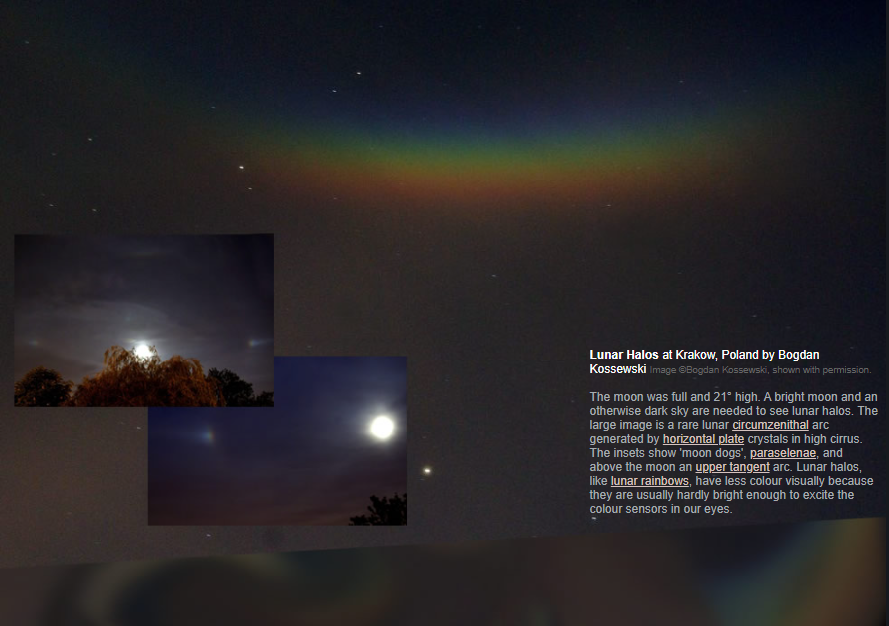Moon Halos
Exploring the Enigmatic Phenomenon of Moon Halos
Have you ever gazed up at the night sky and noticed a halo encircling the moon? These captivating lunar halos, also known as moon rings or winter halos, are an intriguing atmospheric optical phenomenon that occurs when light from the moon is refracted and reflected by ice crystals in the Earth's atmosphere. While we often associate halos with the sun, moon halos offer a mesmerizing display that is worth pondering upon.
Understanding the Science Behind Moon Halos
Moon halos are formed when moonlight interacts with ice crystals present in high-altitude cirrus clouds. These clouds consist of tiny ice crystals that act as prisms, bending and refracting the light passing through them. As the light enters one side of the crystal and exits through another, it gets bent at specific angles. This bending of light results in the formation of a halo around the moon.
The Elements Required for Moon Halo Visibility
To observe a moon halo, certain conditions must align:
- A full or nearly full moon: The brightness of the moon is crucial for illuminating the halo against the dark backdrop of the night sky.
- A high moon: The moon needs to be positioned at least 21° above the horizon for optimal viewing.
- Ice crystals in cirrus clouds: These high-altitude clouds composed of ice crystals serve as the canvas on which moonlight creates its ethereal masterpiece.
A Rare Sight: Lunar Circumzenithal Arcs
Within the realm of moon halos, there exists a particularly rare and captivating phenomenon known as a lunar circumzenithal arc. This awe-inspiring display is generated by horizontal plate crystals within high cirrus clouds. When aligned perfectly, these crystals refract the moonlight in such a way that it creates an arc that appears to be directly above the observer's head. The lunar circumzenithal arc is a remarkable sight, showcasing the intricate interplay between light and ice crystals in our atmosphere.
Unveiling the Beauty of Lunar Halos
Lunar halos are often characterized by their subtle colors, which are less vivid compared to their solar counterparts. The relatively dim moonlight is not typically intense enough to stimulate the color receptors in our eyes. As a result, moon halos predominantly exhibit shades of white and pale pastel hues, lending an air of delicate elegance to these celestial spectacles.
Delving into the Moon Halo Family
Beyond the primary halo encircling the moon, there are several other intriguing optical phenomena that can manifest during a moon halo event:
- Moon Dogs: Also known as paraselenae or mock moons, moon dogs are bright spots of light that appear on either side of the moon. These are caused by the refraction of moonlight through hexagonal ice crystals.
- Upper Tangent Arcs: Positioned above the moon, upper tangent arcs are faint arcs that form due to the interaction between light and ice crystals. These arcs often accompany moon halos, adding an extra touch of mystique to the celestial display.
The Global Presence of Moon Halos
Moon halos are not limited to specific regions; they can be observed in various parts of the world. The occurrence of moon halos is dependent on the presence of cirrus clouds and the availability of moonlight. Therefore, as long as these conditions are met, individuals across different continents can witness the breathtaking allure of moon halos.
Capturing Moon Halos Through Photography
Photographing moon halos can be a rewarding endeavor for those captivated by the beauty of these atmospheric wonders. To capture the essence of a moon halo, it is essential to use longer exposure times and adjust camera settings to enhance the visibility of subtle colors. With careful planning and a bit of luck, photographers can immortalize the enchanting allure of moon halos through their lenses.
Appreciating the Mysteries of the Night Sky
Moon halos serve as a reminder of the profound mysteries that lie beyond our planet. These ethereal displays of light and ice crystals spark curiosity and inspire us to delve deeper into the wonders of atmospheric optics. Whether observed with awe or captured through the lens of a camera, moon halos provide a fleeting yet enchanting glimpse into the captivating beauty of our celestial surroundings.
As we continue to gaze at the night sky, let us embrace the enigmatic allure of moon halos and marvel at the intricate interplay between light, ice crystals, and the mysteries that unfold above us.
Lunar Halos at Krakow, Poland by Bogdan Kossewski Image ©Bogdan Kossewski, shown with permission.
The moon was full and 21° high. A bright moon and an otherwise dark sky are needed to see lunar halos. The large image is a rare lunar circumzenithal arc generated by horizontal plate crystals in high cirrus. The insets show 'moon dogs', paraselenae, and above the moon an upper tangent arc. Lunar halos, like lunar rainbows, have less colour visually because they are usually hardly bright enough to excite the colour sensors in our eyes.

Note: this article has been automatically converted from the old site and may not appear as intended. You can find the original article here.
Reference Atmospheric Optics
If you use any of the definitions, information, or data presented on Atmospheric Optics, please copy the link or reference below to properly credit us as the reference source. Thank you!
-
<a href="https://atoptics.co.uk/blog/moon-halos/">Moon Halos</a>
-
"Moon Halos". Atmospheric Optics. Accessed on November 21, 2024. https://atoptics.co.uk/blog/moon-halos/.
-
"Moon Halos". Atmospheric Optics, https://atoptics.co.uk/blog/moon-halos/. Accessed 21 November, 2024
-
Moon Halos. Atmospheric Optics. Retrieved from https://atoptics.co.uk/blog/moon-halos/.